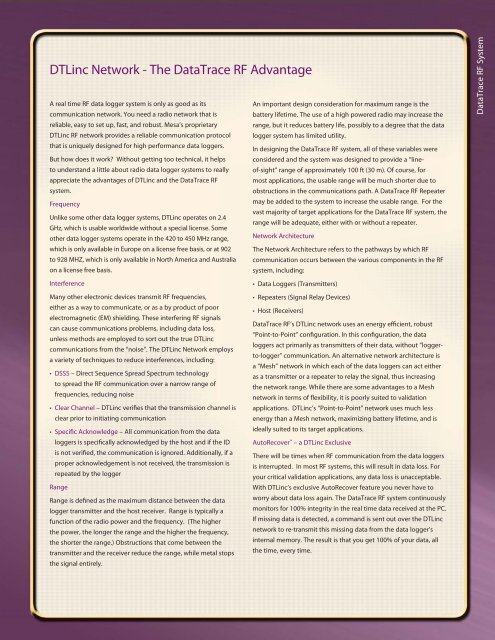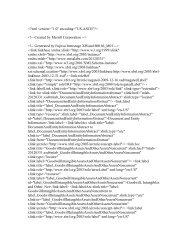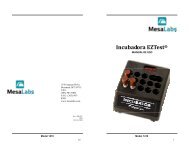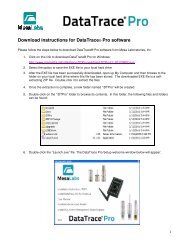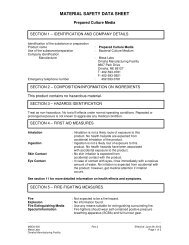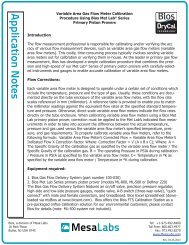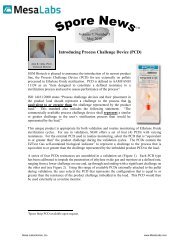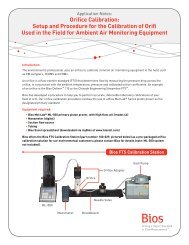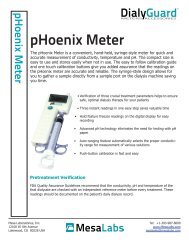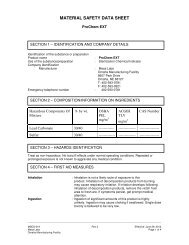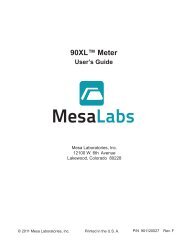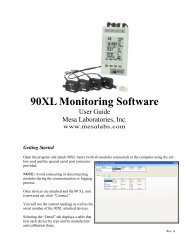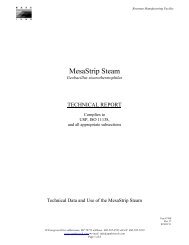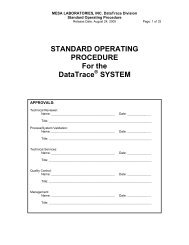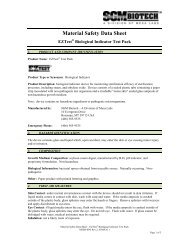DataTrace ® Radio Frequency System - Mesa Labs
DataTrace ® Radio Frequency System - Mesa Labs
DataTrace ® Radio Frequency System - Mesa Labs
You also want an ePaper? Increase the reach of your titles
YUMPU automatically turns print PDFs into web optimized ePapers that Google loves.
DTLinc Network - The <strong>DataTrace</strong> RF AdvantageA real time RF data logger system is only as good as itsAn important design consideration for maximum range is thecommunication network. You need a radio network that isbattery lifetime. The use of a high powered radio may increase thereliable, easy to set up, fast, and robust. <strong>Mesa</strong>’s proprietaryrange, but it reduces battery life, possibly to a degree that the dataDTLinc RF network provides a reliable communication protocol logger system has limited utility.that is uniquely designed for high performance data loggers.In designing the <strong>DataTrace</strong> RF system, all of these variables wereBut how does it work? Without getting too technical, it helps considered and the system was designed to provide a “lineof-sight”range of approximately 100 ft (30 m). Of course, forto understand a little about radio data logger systems to reallyappreciate the advantages of DTLinc and the <strong>DataTrace</strong> RFmost applications, the usable range will be much shorter due tosystem.obstructions in the communications path. A <strong>DataTrace</strong> RF Repeater<strong>Frequency</strong>may be added to the system to increase the usable range. For thevast majority of target applications for the <strong>DataTrace</strong> RF system, theUnlike some other data logger systems, DTLinc operates on 2.4range will be adequate, either with or without a repeater.GHz, which is usable worldwide without a special license. Someother data logger systems operate in the 420 to 450 MHz range, Network Architecturewhich is only available in Europe on a license free basis, or at 902 The Network Architecture refers to the pathways by which RF communication occurs between the various components in the RFon a license free basis.system, including:<strong>DataTrace</strong> RF <strong>System</strong>InterferenceMany other electronic devices transmit RF frequencies,either as a way to communicate, or as a by product of poorelectromagnetic (EM) shielding. These interfering RF signalscan cause communications problems, including data loss,unless methods are employed to sort out the true DTLinccommunications from the “noise”. The DTLinc Network employsa variety of techniques to reduce interferences, including: DSSS – Direct Sequence Spread Spectrum technologyto spread the RF communication over a narrow range offrequencies, reducing noiseClear Channel – DTLinc verifies that the transmission channel isclear prior to initiating communicationSpecific Acknowledge – All communication from the dataloggers is specifically acknowledged by the host and if the IDis not verified, the communication is ignored. Additionally, if aproper acknowledgement is not received, the transmission isrepeated by the loggerRangeRange is defined as the maximum distance between the datalogger transmitter and the host receiver. Range is typically afunction of the radio power and the frequency. (The higherthe power, the longer the range and the higher the frequency,the shorter the range.) Obstructions that come between thetransmitter and the receiver reduce the range, while metal stopsthe signal entirely. Data Loggers (Transmitters) Repeaters (Signal Relay Devices) Host (Receivers)<strong>DataTrace</strong> RF’s DTLinc network uses an energy efficient, robust“Point-to-Point” configuration. In this configuration, the dataloggers act primarily as transmitters of their data, without “loggerto-logger”communication. An alternative network architecture isa “Mesh” network in which each of the data loggers can act eitheras a transmitter or a repeater to relay the signal, thus increasingthe network range. While there are some advantages to a Meshnetwork in terms of flexibility, it is poorly suited to validationapplications. DTLinc’s “Point-to-Point” network uses much lessenergy than a Mesh network, maximizing battery lifetime, and isideally suited to its target applications.AutoRecover – a DTLinc ExclusiveThere will be times when RF communication from the data loggersis interrupted. In most RF systems, this will result in data loss. Foryour critical validation applications, any data loss is unacceptable.With DTLinc’s exclusive AutoRecover feature you never have toworry about data loss again. The <strong>DataTrace</strong> RF system continuouslymonitors for 100% integrity in the real time data received at the PC.If missing data is detected, a command is sent out over the DTLincnetwork to re-transmit this missing data from the data logger’sinternal memory. The result is that you get 100% of your data, allthe time, every time.


